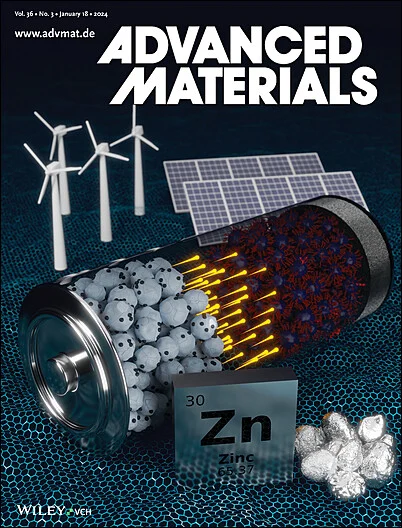促进准 2D/3D 包晶异质结中的载流子传输,实现高性能包晶/有机串联系统
IF 27.4
1区 材料科学
Q1 CHEMISTRY, MULTIDISCIPLINARY
引用次数: 0
摘要
宽带隙(WBG)过氧化物因其在串联太阳能电池中的适用性而持续受到关注。WBG 包晶的主要瓶颈是界面缺陷和大能级偏移导致的界面非辐射性重组和载流子传输损耗,当 WBG 包晶与有机太阳能电池串联堆叠时,由于互连层(ICL)中载流子重组不平衡,会产生额外的能量损耗。为了解决这些问题,我们在 WBG 包晶中加入了 1,3-丙二铵碘化物 (PDADI),以形成具有混合高 n 值的 Dion-Jacobson 相准二维包晶。PDADI 可同时修复浅/深缺陷,并在准 2D/3D 和 3D 包晶石之间建立 II 型能级排列,从而实现快速载流子萃取。更重要的是,高 n 值的准二维包晶中的短链二铵盐阳离子导致 Pb-I 无机层间距变短,从而增强了层间电子耦合,削弱了限制载流子传输的量子阱限制效应。传输损耗的抑制增加了 ICL 中的电子浓度,从而实现了载流子的平衡重组。0.0628 和 1.004 cm2 的过氧化物/有机串联实现了分别为 25.92% 和 24.63% 的出色效率。准二维封盖层可抑制离子迁移,从而使包晶石/有机串联器件表现出卓越的工作稳定性(T85 > 1000 h)。本文章由计算机程序翻译,如有差异,请以英文原文为准。
Boosting Carrier Transport in Quasi‐2D/3D Perovskite Heterojunction for High‐Performance Perovskite/Organic Tandems
Wide‐bandgap (WBG) perovskites are continuously in the limelight owing to their applicability in tandem solar cells. The main bottlenecks of WBG perovskites are interfacial non‐radiative recombination and carrier transport loss caused by interfacial defects and large energy‐level offsets, which induce additional energy losses when WBG perovskites are stacked with organic solar cells in series because of unbalanced carrier recombination in interconnecting layer (ICL). To solve these issues, 1,3‐propanediammonium iodide (PDADI) is incorporated to form Dion–Jacobson ‐phase quasi‐2D perovskites with mixed high‐n‐values in WBG perovskites. PDADI simultaneously repairs the shallow/deep defects and establishes a Type‐II energy‐level alignment between quasi‐2D/3D and 3D perovskites for rapid carrier extraction. More importantly, the short‐chain diammonium cation in quasi‐2D perovskite with high n‐values results in a short Pb–I inorganic layer spacing, which enhances the interlayer electronic coupling and weakens the quantum‐well confinement effect that restricts carrier transport. The suppressed transport loss increases the electron concentration in the ICL for balanced carrier recombination. The 0.0628 and 1.004 cm2 perovskite/organic tandems achieve remarkable efficiencies of 25.92% and 24.63%, respectively. The quasi‐2D capping layer can inhibit ion migration, allowing perovskite/organic tandems to show excellent operational stability (T 85 > 1000 h).
求助全文
通过发布文献求助,成功后即可免费获取论文全文。
去求助
来源期刊

Advanced Materials
工程技术-材料科学:综合
CiteScore
43.00
自引率
4.10%
发文量
2182
审稿时长
2 months
期刊介绍:
Advanced Materials, one of the world's most prestigious journals and the foundation of the Advanced portfolio, is the home of choice for best-in-class materials science for more than 30 years. Following this fast-growing and interdisciplinary field, we are considering and publishing the most important discoveries on any and all materials from materials scientists, chemists, physicists, engineers as well as health and life scientists and bringing you the latest results and trends in modern materials-related research every week.
 求助内容:
求助内容: 应助结果提醒方式:
应助结果提醒方式:


